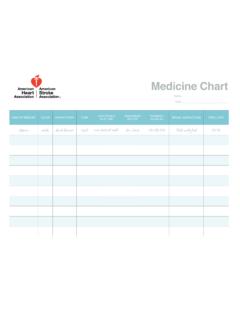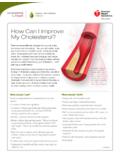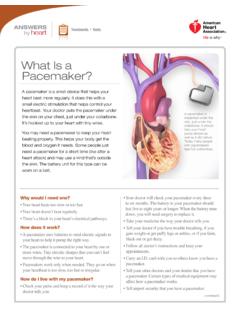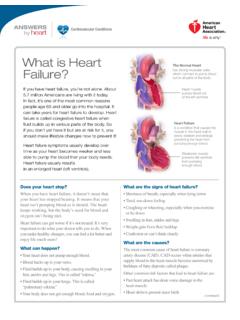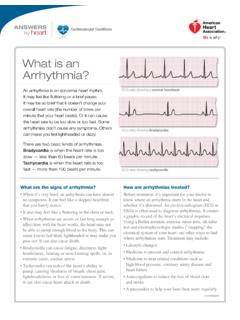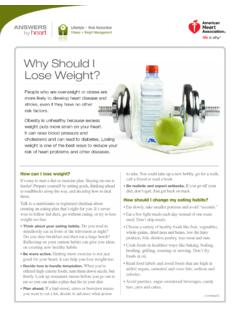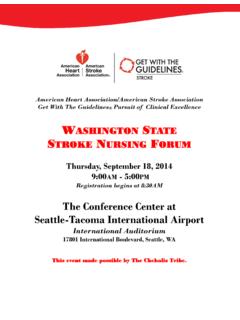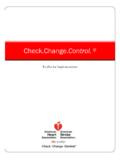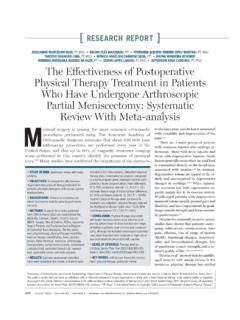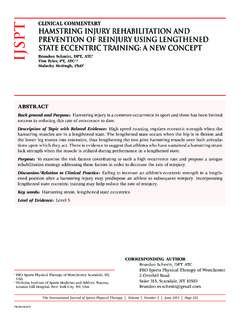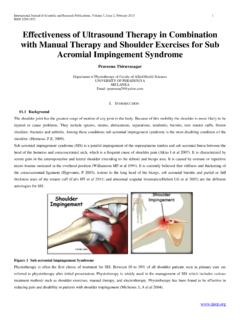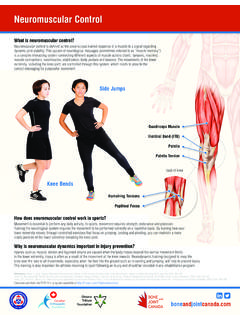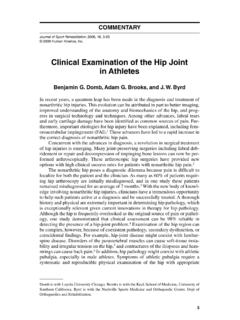Transcription of Cardiac Rehabilitation Putting More Patients on the …
1 American Heart Association Advocacy Department 1150 Connecticut Ave. NW Suite 300 Washington, DC 20036 Phone: (202) 785-7900 Fax: (202) 785-7950 FACTS Cardiac Rehabilitation Putting More Patients on the Road to Recovery OVERVIEW Each year, over 800,000 Americans die from cardiovascular disease, accounting for 1 of every 3 deaths in the However, there is hope. The goal of Cardiac Rehabilitation (CR) is to reduce the risk of a future Cardiac event by stabilizing, slowing, or even reversing the progression of cardiovascular disease (CVD).
2 2 As a result, CR reduces hospital readmissions, as well as all-cause and CVD ,4 Patients with other cardiovascular conditions, such as heart failure can also benefit from CR ,6 Despite its clear and tangible benefits, CR remains underutilized, particularly among women and ,8,9 A 2016 report estimated that only 19-34% of Patients subsequently participate in a CR A 2015 study reported that just over 20% of eligible Medicare Patients with acute myocardial infarction used CR So, why aren t more Patients and their physicians making greater use of Cardiac Rehabilitation ? Unfortunately, there are many barriers that contribute to low participation rates (Table 1).
3 Nevertheless, new delivery models, such as automatic in-patient CR referral systems, offer opportunities to address patient barriers and to lower treatment ,13 The Million Hearts initiative has developed a roadmap to increase participation in Cardiac Rehabilitation which includes referrals, increased enrollment, and adherence of Researchers have predicted that the Million Hearts initiative to increase Cardiac Rehabilitation could save 25,000 lives and prevent 180,000 hospitalizations annually in the WHAT IS Cardiac Rehabilitation ? Cardiac Rehabilitation is a medically-supervised program consisting of exercise training, education on heart-healthy living, counseling to reduce stress, and helping Patients return to an active lifestyle and recover sooner.
4 CR offers a multifaceted and highly tailored approach to boost the overall physical, mental, and social functioning of people with heart-related problems. It is recommended for both inpatient and outpatient settings for the following conditions:13,14 Acute myocardial infarction (heart attack) Chronic stable angina Coronary artery bypass grafting (CABG) Percutaneous coronary intervention (PCI) Cardiac valve surgery Stable, chronic heart failure Cardiac transplantation Medicare reimbursement guidelines limit CR to a maximum of two one-hour sessions per-day, up to 36 sessions provided over a period of up to 36 weeks with the option for an additional 36 Programs must include five basic Physician-prescribed exercise Cardiac risk factor modification (education, counseling, and behavioral intervention) Psychosocial assessment Outcomes assessment Individual treatment plans Table 1.
5 BARRIERS TO UTILIZATION1,2 Lack of referral to participate from the patient s physician Lack of perceived need for Rehabilitation /awareness of CR Limited, or no health care coverage (cost) Limited follow-up or facilitation of enrollment after referral Work or home responsibilities Hours of operation conflicting with work demands Scarcity of programs in rural areas and/or low-income communities Distance to CR facility from patient s home Access to public transportation or parking issues Male gender-dominated programs and little racial staff diversity Language problems and cultural beliefs Medicare provides reimbursement for all the recommended conditions, although coverage for heart failure (HF)
6 Is limited to Patients with compromised ejection fraction the ability of the heart to pump out blood (about half of the HF patient population).15,16 HEALTH BENEFITS Studies have shown that Cardiac Rehabilitation can improve the health and recovery of those who suffer from CVD. The following benefits of CR have been reported: 45-47% reduction in all-cause mortality in Patients who participated in CR after percutaneous coronary intervention compared to 31% lower hospital Improved adherence with preventive Increased exercise Improved health factors, such as blood pressure, exercise capacity.
7 19 and lipid Enhanced ability to perform daily Improved psychosocial symptoms and health-related quality of FINANCIAL BENEFITS A 2011 analysis reported that better health outcomes from Cardiac Rehabilitation were associated with reduced hospitalizations and use of medical A study presented at the Canadian Cardiovascular Congress found that CR resulted in a 31% reduction in hospital readmissions and a 26% drop in cardiovascular mortality for a 7% return on investment. 24 Another study found that CR can save Patients $640 per quality-adjusted year of life ENROLLMENT IS LIMITED The elderly, women, minority populations, and Patients with lower socioeconomic status are less likely to be referred to CR, and unfortunately.
8 Are less likely to take that first critical step to enroll after This is of great concern because women and minorities are far more likely to die within five years after a first heart attack as compared to their white male patient THE ASSOCIATION ADVOCATES The American Heart Association is committed to public policies that will reduce the CR treatment gap with a specific focus on the most underserved populations: women, minorities, and low-income individuals. These policies include: Support legislation that would allow physician assistants, nurse practitioners and clinical nurse specialists to directly supervise Patients in Cardiac and pulmonary Rehabilitation programs on a day-to-day basis under Medicare.
9 Support for the Million Hearts initiative which aims to prevent 1 million CVD One component is to ensure that those who need CR are properly referred and increase CR enrollment and Support CMS CR Incentive Payment Model which encourages improved participation among hospitals, physicians, and post-acute care providers. Support alternative models to traditional CR that address transportation barriers and responsibilities at home or work. Encourage the creation and dissemination of information on the benefits of CR to physicians and health plans to enhance referral, follow-up, and reduce costs.
10 1 Blaha B, et al. 2017. Heart Disease and Stroke Statistics 2017 Update: A Report From the American Heart Association. Circulation. 2017; e205. 135:00 00. DOI: 2 Balady GJ., et Referral, enrollment, and delivery of Cardiac Rehabilitation /secondary prevention programs at clinical centers and beyond: a presidential advisory from the American Heart Association. Circulation; 124:2951-2960. 3 Goel, K., et al. 2011. Impact of Cardiac Rehabilitation on mortality and cardiovascular events after percutaneous coronary intervention in the community. Circulation 123(21): 2344-2352. 4 Dunlay, SM et al.
